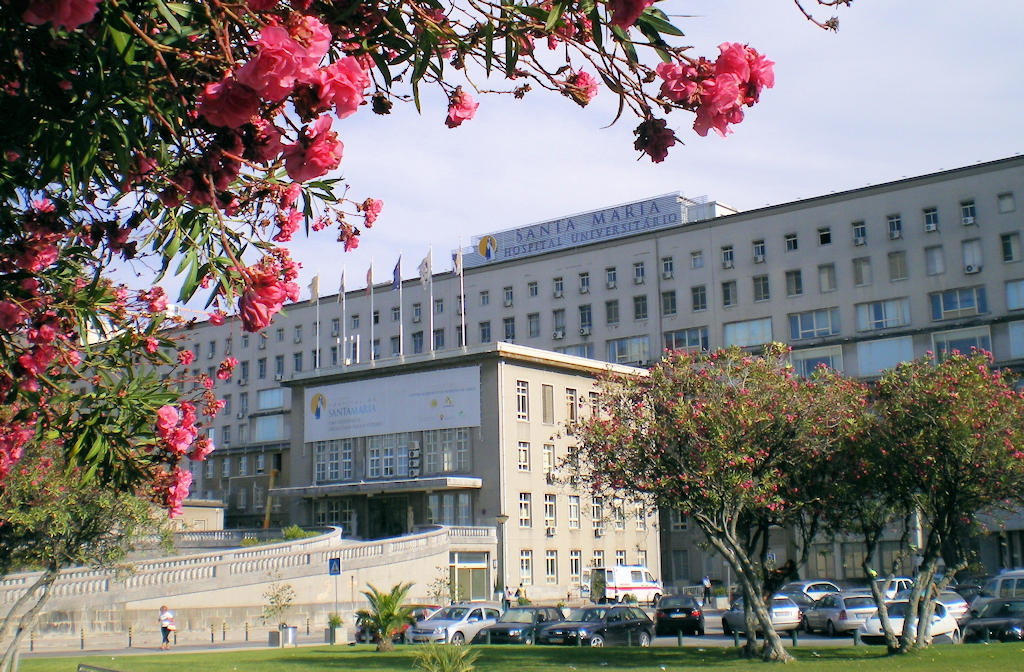During the construction, a decree-law was issued in 1952, transferring all hospitals to the Ministry of the Interior, resulting in the Hospital Escolar de Lisboa transitioning from the Ministry of Education to the University Hospital of Santa Maria. This change meant that the hospital came under the supervision of two different ministries. The official inauguration of the building took place on April 27, 1953, and in October of the same year, the new academic year of the Faculty of Medicine at the University of Lisbon commenced in the hospital's new facilities.
In 1968, the construction of the nursing school buildings funded by the Calouste Gulbenkian Foundation began on the Santa Maria Hospital grounds. The works were completed in 1972, and the nursing school was relocated to the new facilities, becoming the Calouste Gulbenkian Nursing School, now known as the Lisbon School of Nursing. In 1975, a decree-law was issued, extinguishing the School Hospitals and integrating them into the regular hospital system.
In 2004, the Egas Moniz Building was inaugurated on the hospital grounds, housing the Faculty of Medicine of the University of Lisbon and the Institute of Molecular Medicine. That same year, a decree-law was enacted, restoring the designation of University Hospital to Santa Maria Hospital. In January 2007, Santa Maria Hospital became a Public Business Entity (EPE), implementing the 2006-2008 Strategic Plan for the comprehensive redevelopment of the hospital.
On October 9, 2007, the South Wing project, known as the Cid dos Santos Building, was presented. This building is intended to accommodate operating rooms, intensive care units, ambulatory surgery, as well as dedicated areas for neurosciences and maternal-child care. Since December 27, 2007, Santa Maria Hospital has been part of the Centro Hospitalar Universitário Lisboa Norte EPE (CHULN), along with Pulido Valente Hospital.
As of 2016, Santa Maria Hospital employs 2,722 healthcare professionals, providing exceptional medical care and expertise to the community. With its affiliation to the University of Lisbon's Faculty of Medicine and the Institute of Molecular Medicine, Santa Maria Hospital remains at the forefront of medical research, education, and healthcare in Portugal.
Hospital de Santa Maria, offers a comprehensive range of medical specialties to meet the healthcare needs of the community. The hospital is organized into various departments, each dedicated to specific areas of expertise. The Department of Vascular and Endovascular Surgery consists of two services specializing in vascular surgery. The Department of Medicine encompasses several services, including Dermatology, Infectious Diseases, Endocrinology, Gastroenterology and Hepatology, Immunology and Allergy, as well as Nephrology and Renal Transplantation, among others.
Lisbon.vip Recommends
Neurosciences are represented by the Department of Neurosurgery, Neurology, Ophthalmology, and Psychiatry and Mental Health. The Department of Complementary Diagnostic Methods encompasses services such as Pathological Anatomy, General Imaging, Neurological Imaging, Immunohematology, Physical Medicine, Rehabilitation, and Clinical Pathology. Oncology services include Hematology and Bone Marrow Transplantation, Medical Oncology, and Radiation Therapy.
The Department of Otorhinolaryngology, Voice, and Communication Disorders focuses on disorders related to the ear, nose, and throat, including communication difficulties. The Department of Thorax covers Cardiology, Cardiothoracic Surgery, Thoracic Surgery, and Pulmonology. Additionally, the hospital houses the Department of Emergency and Intensive Care, with services in Intensive Medicine and Central Emergency.
Other clinical services provided by Hospital de Santa Maria include Anesthesia, ensuring patients' comfort and safety during medical procedures. With a comprehensive range of specialties and services, the hospital aims to deliver high-quality care to patients, addressing various medical needs and conditions with the expertise of its dedicated healthcare professionals.
Map View



